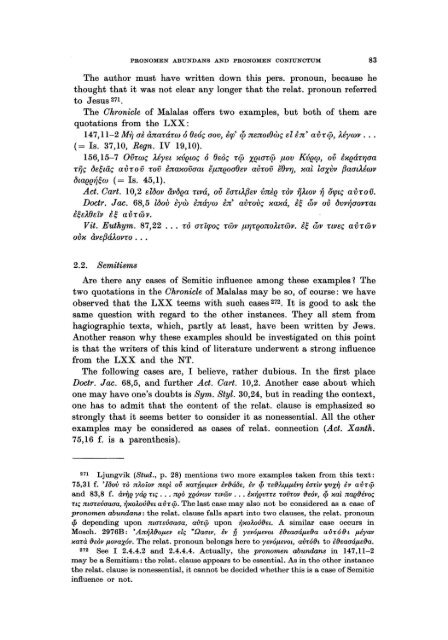Pronomen Abundans and Pronomen Coniunctum. A ... - DWC
Pronomen Abundans and Pronomen Coniunctum. A ... - DWC
Pronomen Abundans and Pronomen Coniunctum. A ... - DWC
Create successful ePaper yourself
Turn your PDF publications into a flip-book with our unique Google optimized e-Paper software.
PRONOMEN ABUNDANS AND PRONOMEN CONJUNCTUM 83<br />
The author must have written down this pers. pronoun, because he<br />
thought that it was not clear any longer that the relat. pronoun referred<br />
to J es us 271.<br />
The Chronicle of Malalas offers two examples, but both of them are<br />
quotations from the LXX :<br />
147,11-2 M~ aè Wraiát"W Ó fJe6ç aov, èq/ cp 1te1WtfJwç el è1t' avnp, Uywv . ..<br />
(= Is. 37,10, Regn. IV 19,10).<br />
156,15-7 OViWÇ Uyet ~vewç Ó fJeoç iep xetanp fWV Kvecp, ou eXeái'YJaa<br />
iijÇ i5eçtaç aViov iOV e1ta~ovaat ëft1teoafJev aViov ëfJv'YJ, ~ai laxvv f3aatUwv<br />
i5taeençw (= Is. 45,1).<br />
Act. Cart. 10,2 eli50v ávi5ea nvá, ou ëanÀf3ev {mèe iOV ifÀwv ~ ö'ljJtç aViov.<br />
Doctr. Jac. 68,5 li50v èyw e1táyw e1t' aViovç ~a~á, eç d)v ov i5vvf]aovTat<br />
eçeÀfJûv eç aViwv.<br />
Vit. Euthym. 87,22 ... iO aûtpoç iWV ft'YJie01tOÀtiWV. eç d)v nveç aViwv<br />
ov~ àvef3áÀoviO . ..<br />
2.2. Semitism8<br />
Are there any cases of Semitic influence among these examples? The<br />
two quotations in the Chronicle of Malalas may be so, of course: we have<br />
observed that the LXX teems with such cases 272. It is good to ask the<br />
same question with regard to the other instances. They all stem from<br />
hagiographic texts, which, partly at least, have been written by Jews.<br />
Another reason why these examples should be investigated on this point<br />
is that the writers of this kind of literature underwent astrong influence<br />
from the LXX <strong>and</strong> the NT.<br />
The following cases are, I believe, rather dubious. In the fust place<br />
Doctr. Jac. 68,5, <strong>and</strong> further Act. Cart. 10,2. Another case ab out which<br />
one may have one's doubts is Sym. Styl. 30,24, but in reading the context,<br />
one has to admit that the content of the relat. clause is emphasized so<br />
strongly that it seems better to consider it as nonessential. All the other<br />
examples may be considered as cases of relat. connection (Act. Xanth.<br />
75,16 f. is a parenthesis).<br />
271 Ljungvik (Stud., p. 28) mentions two more examples taken from this text:<br />
75,31 f. '16011 Ta nÀoiov nEel ou )(aTfJEIp.ev lvf)á&, lv cp TcfHIP.p.év1) laûv1pVxfJ lv aVTl/J<br />
<strong>and</strong> 83,8 f. àvfJe Yele nç .. . nea xeóvwv nvwv . . . l)(1)eVTTE TOVTOV Ihóv, cp )(al nae{}évoç<br />
nç maTEvaaaa, 'Ij)(oÀovifu aVTl/J. The last case mayalso not be considered as a case of<br />
pronomen abundans : the relat. clause falls apart into two clauses, the relat. pronoun<br />
cp depending upon maTEvaaaa, aVTl/J upon 'Ij)(OÀ06f}EI. A similar case occurs in<br />
Mosch. 2976B: 'An1)À{}op.EV elç vQaalv, lv fJ yevóp.evol lifwaáp.E{}a aVTó{}1 p.Éyav<br />
)(aTà {}Eav p.ovaxóv. The relat. pronoun belongs here to yevÓP.EVOI, aVTó{}1 to l{}waáp.E{}a.<br />
272 See I 2.4.4.2 <strong>and</strong> 2.4.4.4. Actually, the pronomen abundans in 147,11-2<br />
may be a Semitism: the relat. clause appears to be essential. As in the other instance<br />
the relat. clause is nonessentiaI, it cannot be decided whether this is a case of Semitic<br />
infiuence or not.
















